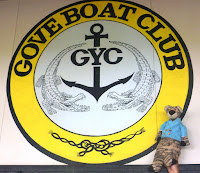After several
long sailing days from Airlie Beach, with favourable SE winds, we stocked up in
Townsville then took another short break at Port Douglas, also to find some
spare parts (always something breaking!).
Next stop
Hope Island, where we met SV Cool Change, Matt and Lisa, and MV Sealeaf, Brian
and Sandra, who are also planning a Kimberley trip this year.
Beyond Cape
Flattery, we were into new territory, as far north as we had ever sailed Heatwave. The shipping lane is very close to the coast
here and small islets, surrounded by large reefs and rocks, dot the whole
region, so constant lookout was necessary. Ninian Bay offered a safe anchorage,
but wake from the passing ships did make it a bit lumpy at times.

Next
morning we had a perfect downwind run along the edge of the shipping channel to
The Flinders Islands, where we hoped to stay a few days. Rounding Cape Melville, with its rugged,
rocky headlands, it was difficult to see Channel Rocks at high tide, so the
starboard marker on it was welcomed. Further in, Bathurst Bay was the scene of
Queensland’s worst cyclone, Mahina in March 1899, which destroyed 50 pearl
luggers and their mother ships, killing about 300 people. The official number was not known as many of
the divers and ship hands were from Torres Strait and Pacific Islands, referred
to on the memorial as “over 300 coloured men”.
Very sad.
Sailing
into the Owen Channel between Flinders Island and Stanley is like a bar
crossing as the waves surge through the narrow channel. Castle Peaks, at the entrance, create a
dramatic sight, at first you see one peak, then it becomes two.
The first anchorage is tricky to negotiate,
with fringing reefs and bommies to dodge.
Along the campground beach masses of soft coral float near the surface
resembling a giant kelp garden.
There
are ancient artworks in caves on Stanley Island, but with winds increasing it
was too rough to attempt to dinghy in to the start of the walk. Have to leave that one for next time...
Leaving
Flinders we sailed past even smaller islands with even littler lights, most
surrounded by massive reefs and long sand spits.
 |
| Wharton Reef |
On our walk
around Morris Island we had our first croc encounter: fresh tracks from the beach across to the
water at the western end of the island.
Nigel and Kerry had also seen fresh tracks on the southern side, so it
was back to the boat quick smart, it was already getting late.
Alan Lucas described Morris Island as having
one significant coconut palm, but since then it has had babies, now 5 palms,
and the introduction of agave plants, a dreadful weed, has impacted severely on
the vegetation, leaving the thousands of black noddies to roost on the few
remaining trees.
 |
| Black Noddies |
On top of that, rubbish
litters the shores around most of the island: plastic water bottles, thongs, fishing
nets and assorted plastics . One
intriguing piece of flotsam resembled a spaceship.
Birds on
Morris Island: greater frigatebird, thousands
of black noddies, silver gulls, pied oystercatchers, reef egrets (white morph),
and a small flock of shorebirds, possibly sand plovers.
Duet and
Nomad Davina opted to push on to Portland Roads while we decided to check out
Night Island, also as an anchorage for the return journey. We were on our own again... with just the
cheerful calls of the varied honeyeaters and pied oystercatchers. Around sunset hundreds of lorikeets flew in
to roost for the night.
Night
Island gave us a pleasant anchorage and as I was about to take photos of the
shores when our second croc encounter occurred.
A 3 metre croc swam along our port side and eyeballed me (shiver!!). He then dived at our stern but came back to
have another look at us. We decided not
to check out this beach, but stay aboard.
 |
| Smile Crocodile! |


































.JPG)
.JPG)

